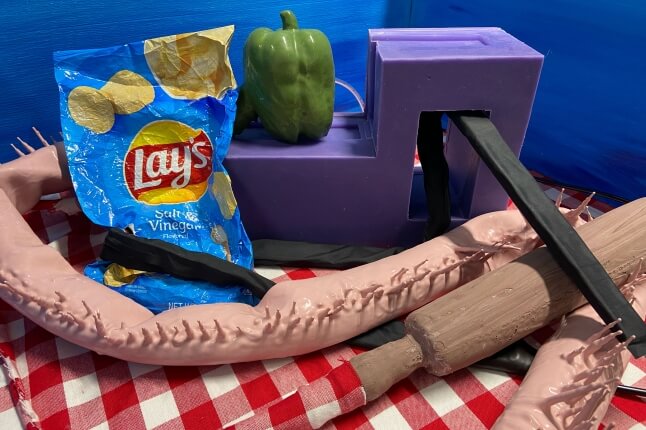News
Game design challenge requires students to think outside the box
Students were in final production mode, as they prepared to conclude the game design challenge in the Harvard John A. Paulson School of Engineering and Applied Sciences course Design Survivor: Experimental Lessons in Designing for Desirability (ES 22)
Seven teams, comprised of graduate students, undergraduates, and visiting students, from both technical and non-technical backgrounds, would later present their ideas and receive feedback from an expert in venture capital.
Course creator and professor Beth Altringer, Senior Preceptor in Innovation and Design, said, “By accommodating students from all levels, we are offering everyone a unique opportunity to collaborate with different types of people with different skillsets.”
Teammates Kelvin Tejeda and Elyse Voegeli work on their PAC-MAN game. (Photo by Manasa Joshyam/SEAS Communications)
One team, comprised of Elyse Voegeli, a master of public policy student at the Harvard Kennedy School, and Kelvin Tejeda, a visiting student from Williams College, collaborated to prototype a PAC-MAN game that could be played on the digital screens in subway stations using an individual’s smart phone.
“When you enter the code, you can use your phone to control the game and let others waiting watch your game. There is going to be a station high score of the day,” Voegeli explained. “It is going to be a fun, interactive game.”
Another team, comprised of Jeanine Zheng, A.B. ’20, a joint concentrator in environmental science and visual design, Arjun Mirani, A.B. ’20, a math and physics concentrator, and Madeleine Lapuerta, A.B. ’20, a computer science concentrator, worked to create a game with an educational mission, called TerraCoda.
“With this game, we want to teach people coding in a fun, interactive way,” said Zheng. “It is an intro game to three different languages, so we structured the game around these languages. We have a Python jungle, underwater SEA world, and a JAVA café.”
The game incorporates different coding challenges, initially testing a user’s basic skills and then building up to more advanced programming techniques.
Teammates Madeleine Lapuerta, Jeanine Zheng, and Arjun Mirani explain the concept of their educational game to instructor Beth Altringer. (Photo by Manasa Joshyam/SEAS Communications)
While the students focused on the 'nuts and bolts' of their game designs during this class session, the theoretical basis of the course, according to Altringer, is more about desirability.
“Tools are always changing and I don’t think of that as a primary barrier for taking this class. While we let students use tools that are right for each of their level of design experience, what we are really trying to teach is how to design things to be desirable in a thoughtful way, to whomever you are designing for,” she said. “This challenge, in particular, is around highly engaging interactivity. So, we learn what is engagement from a psychological standpoint and how to take lessons from the examples that we’ve studied and apply them in our design. Yes, you need a great product, but you have to be able to defend the desirability decisions you have made in your prototype.”
“I love it. It [the course] is definitely more applied than traditional education and that is why I came here—to make things and use the knowledge that I have accrued to build something,” said Tejeda.
“It is a fun course for someone who is just beginning in design. I enjoy the immersive, hands-on experience,” said Jorgen Stromsnes, a visiting student from Norway.
“We really do want to see everyone become much more competent designers across their challenges, and we do see that,” added Altringer.
Teammates (from left) Eunsu Kim, Jorgen Stromsnes, and Luke Xu created a volleyball game with animal players, each of whom had a different superpower. (Photo by Manasa Joshyam/SEAS Communications)
Cutting-edge science delivered direct to your inbox.
Join the Harvard SEAS mailing list.


